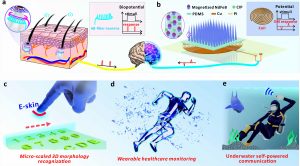A research team led by Zhou Bingpu, an associate professor at the Institute of Applied Physics and Materials Engineering (IAPME), University of Macau (UM), has designed a self-powered and multifunctional electronic skin (e-skin) that can not only mimic human skin in terms of tactile perception, but is also capable of quantitative recognition of 3D surface information. With its high-capacity communication capability, the e-skin is expected to be applied in various scenarios, such as real-time health monitoring, recognition and reconstruction of micro-scaled topography, and underwater communication. The research results have been published in Advanced Functional Materials, a leading international journal in the field.
As electronic devices that mimic human skin, e-skins are expected to have similar sensory functions, including tactile perception and the ability to interact with the environment. Although most of the e-skins today are capable of sensing tactile intensity or pressure, quantitative recognition of 3D surface morphology remains a challenge for them. Furthermore, it is desirable that e-skins can generate commands in response to different mechanical stimuli and work stably in different environments.
Inspired by human skin, the research team has designed a flexible e-skin consisting of a whisker-like magnetised micro-cilia array (MMCA) and flexible coils. With the built-in alignment of magnetic moments, the mechanical stimuli-induced MMCA deformation can generate related voltage signals within the coils to provide feedback for reflecting the external pressure and surface morphology. The study systematically investigated the relationship between the induced voltage and pressure, and optimised the MMCA to ensure a reliable voltage profile that can quantitatively reflect the 3D information of the surface morphology. By customising the alignment of magnetic moments, the e-skin can further output multiple voltage waveforms as information codes on one device for efficient human-machine interaction and high-capacity transmission. As the perception capability of the e-skin is originated from the electromagnetic response, the e-skin is self-powered and can work stably in harsh conditions such as high temperature or underwater. The study comprehensively shows the strengths of the e-skin in different applications, such as real-time health monitoring (including the recognition of breath status and joint bending), Braille identification, reconstruction of relief information, high-capacity command transmission, and Morse code communication underwater.
The corresponding author of this study is Prof Zhou, and the first author is Zhou Qian, a PhD student at IAPME. The project was funded by the Science and Technology Development Fund, Macao SAR (File no: 0088/2021/A2 and 0026/2020/AGJ) and the Department of Science and Technology of Guangdong Province (2021A0505080004). The full version of the paper can be viewed at https://onlinelibrary.wiley.com/doi/10.1002/adfm.202208120
| Source: Institute of Applied Physics and Materials Engineering | |
| Media Contact Information: | |
| Communications Office, University of Macau | |
| Albee Lei | Tel: (853) 8822 8004 |
| Cathy Cheang | Tel: (853) 8822 8009 |
| Email: | prs.media@um.edu.mo |


